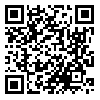Volume 18, Issue 4 (6-2019)
JRUMS 2019, 18(4): 365-376 |
Back to browse issues page
Download citation:
BibTeX | RIS | EndNote | Medlars | ProCite | Reference Manager | RefWorks
Send citation to:



BibTeX | RIS | EndNote | Medlars | ProCite | Reference Manager | RefWorks
Send citation to:
Taheri P, Vahdatpour B, Andalib S, Baradaran Mahdavi S. The Effect of Low-Level Laser Therapy, Exercise Therapy and Medication on Myofascial Pain Syndrome of Upper Trapezius: A Clinical Trial Study. JRUMS 2019; 18 (4) :365-376
URL: http://journal.rums.ac.ir/article-1-4148-en.html
URL: http://journal.rums.ac.ir/article-1-4148-en.html
Isfahan University of Medical Sciences, Isfahan, Iran
Abstract: (3063 Views)
Background and Objectives: Since the myofascial pain syndrome is a common condition in the trapezius muscle, the present study aimed to determine and compare the effects of laser therapy, exercise and medication among patients diagnosed with myofascial pain syndrome of the upper trapezius muscle, referred to the clinics of physical medicine in Isfahan in 2013.
Materials and Methods: In this clinical trial study, 44 patients were randomly assigned to an exercise-medication treatment group (24 individuals) and a laser-exercise-medication treatment group (20 individuals). Symptoms were assessed based on Visual Analogue Scale ( VAS) , Neck Disability Index (NDI), and Shoulder Pain and Disability Index (SPDI) in three stages including before treatment, subsequently after treatment and one month after treatment. Independent t-test and repeated measures ANOVA were used to analyze the statistical data.
Results: A significant difference was found among the studied groups before and after starting treatment for VAS, NDI and SPDI indices (p<0.001). However, laser therapy provided a higher effect on VAS in comparison with the control group subsequently after treatment (p=0.032). Nevertheless, evaluation after one month from treatment did not show a significant difference in the 2 treatment methods for the three indices (p>0.05).
Conclusion: According to the results, exercise-medication therapy and laser-exercise-medication therapy may result in similar effects for relieving pain and eliminating symptoms in patients with myofascial pain syndrome in long-term, but subsequently after treatment, laser-exercise-medication therapy provides a higher effect on VAS.
Key words: Exercise therapy, Drug therapy, Laser therapy, Myofascial pain syndrome
Funding: This study was funded by Isfahan University of Medical Sciences.
Conflict of interest: None declared.
Ethical approval: The Ethics Committee of Isfahan University of Medical Sciences approved the study (392364).
How to cite this article: Taheri P, Vahdatpour B , Andalib S, Baradaran Mahdavi S. The Effect of Low-Level Laser Therapy, Exercise Therapy and Medication on Myofascial Pain Syndrome of Upper Trapezius: A Clinical Trial Study. J Rafsanjan Univ Med Sci 2019; 18 (4): 365-76. [Farsi]
Materials and Methods: In this clinical trial study, 44 patients were randomly assigned to an exercise-medication treatment group (24 individuals) and a laser-exercise-medication treatment group (20 individuals). Symptoms were assessed based on Visual Analogue Scale ( VAS) , Neck Disability Index (NDI), and Shoulder Pain and Disability Index (SPDI) in three stages including before treatment, subsequently after treatment and one month after treatment. Independent t-test and repeated measures ANOVA were used to analyze the statistical data.
Results: A significant difference was found among the studied groups before and after starting treatment for VAS, NDI and SPDI indices (p<0.001). However, laser therapy provided a higher effect on VAS in comparison with the control group subsequently after treatment (p=0.032). Nevertheless, evaluation after one month from treatment did not show a significant difference in the 2 treatment methods for the three indices (p>0.05).
Conclusion: According to the results, exercise-medication therapy and laser-exercise-medication therapy may result in similar effects for relieving pain and eliminating symptoms in patients with myofascial pain syndrome in long-term, but subsequently after treatment, laser-exercise-medication therapy provides a higher effect on VAS.
Key words: Exercise therapy, Drug therapy, Laser therapy, Myofascial pain syndrome
Funding: This study was funded by Isfahan University of Medical Sciences.
Conflict of interest: None declared.
Ethical approval: The Ethics Committee of Isfahan University of Medical Sciences approved the study (392364).
How to cite this article: Taheri P, Vahdatpour B , Andalib S, Baradaran Mahdavi S. The Effect of Low-Level Laser Therapy, Exercise Therapy and Medication on Myofascial Pain Syndrome of Upper Trapezius: A Clinical Trial Study. J Rafsanjan Univ Med Sci 2019; 18 (4): 365-76. [Farsi]
Type of Study: Research |
Subject:
Rehabilitation
Received: 2018/01/27 | Accepted: 2019/01/21 | Published: 2019/06/15
Received: 2018/01/27 | Accepted: 2019/01/21 | Published: 2019/06/15
Send email to the article author
| Rights and permissions | |
 |
This work is licensed under a Creative Commons Attribution-NonCommercial 4.0 International License. |







